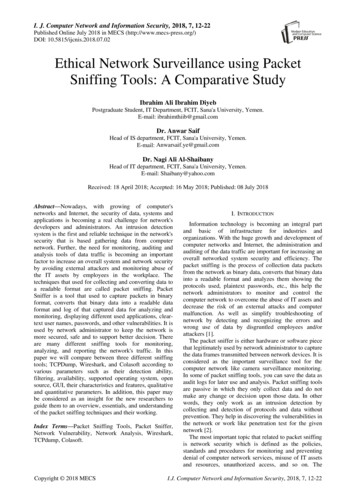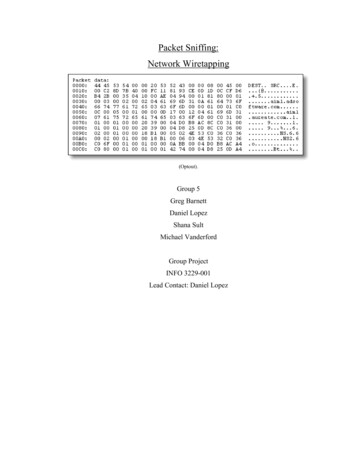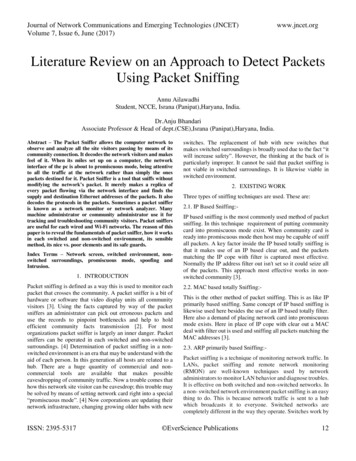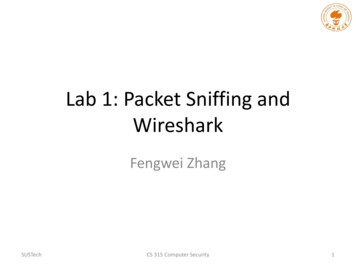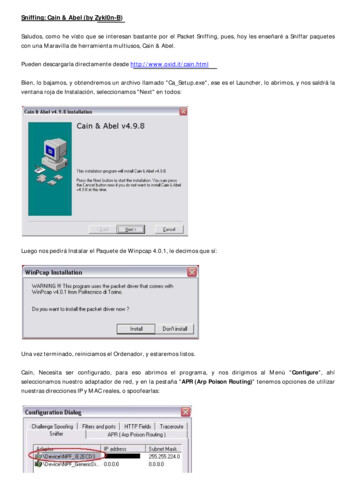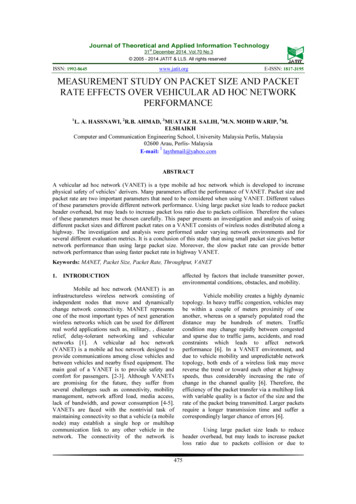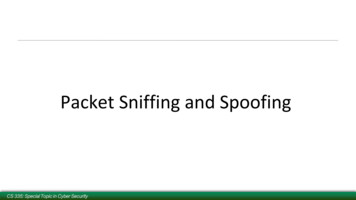
Transcription
Packet Sniffing and Spoofing
How Packets Are Received NIC (Network Interface Card) is a physical or logical link between amachine and a network Each NIC has a MAC address Every NIC on the network will hear all the frames on the wire NIC checks the destination address for every packet, if the addressmatches the cards MAC address, it is further copied into a buffer in thekernel
Promiscuous Mode The frames that are not destined to a given NIC are discarded When operating in promiscuous mode, NIC passes every frame receivedfrom the network to the kernel If a sniffer program is registered with the kernel, it will be able to see allthe packets In Wi-Fi, it is called Monitor Mode
BSD Packet Filter (BPF) BPF allows a userprogram to attach afilter to the socket,which tells the kernelto discard unwantedpackets. An example of thecompiled BPF code isshown here.
BSD Packet Filter (BPF)setsockopt(sock, SOL SOCKET, SO ATTACH FILTER, &bpf, sizeof(bpf)) A compiled BPF pseudo-code can be attached to a socket throughsetsockopt() When a packet is received by kernel, BPF will be invoked An accepted packet is pushed up the protocol stack. See the diagramon the following slide.
Packet Flow With/Without Filters
Packet SniffingPacket sniffing describes the process of capturing live data as they flowacross a networkLet’s first see how computers receive packets.
Receiving Packets Using SocketCreate the socketProvide informationabout serverReceive packets
Receiving Packets Using Raw SocketCreating a raw socketCapture all types of packetsEnable thepromiscuousmodeWait for packets
Limitation of the Approach This program is not portable across different operating systems. Setting filters is not easy. The program does not explore any optimization to improveperformance. The PCAP library was thus created.– It still uses raw sockets internally, but its API is standard across allplatforms. OS specifics are hidden by PCAP’s implementation.– Allows programmers to specify filtering rules using human readableBoolean expressions.
Packet Sniffing Using the pcap APIInitialize a rawsocket, set thenetwork deviceinto promiscuousmode.FilterInvoke this function for every captured packet
Processing Captured Packet: Ethernet HeaderThe packet argumentcontains a copy of thepacket, including theEthernet header. Wetypecast it to the Ethernetheader structure.Now we can access thefield of the structure
Processing Captured Packet: IP HeaderFind where the IP headerstarts, and typecast it tothe IP Header structure.Now we can easily accessthe fields in the IPheader.
Further Processing Captured Packet If we want to further process the packet, such as printing out theheader of the TCP, UDP and ICMP, we can use the similar technique.– We move the pointer to the beginning of the next header and type-cast– We need to use the header length field in the IP header to calculate the actualsize of the IP header In the following example, if we know the next header is ICMP, we canget a pointer to the ICMP part by doing the following:
Packet Spoofing When some critical information in the packet is forged, werefer to it as packet spoofing. Many network attacks rely on packet spoofing. Let’s see how to send packets without spoofing.
Sending Packets Without SpoofingTesting: Use the netcat (nc)command to run a UDP serveron 10.0.2.5. We then run theprogram on the left fromanother machine. We can seethat the message has beendelivered to the server machine:
Spoofing Packets Using Raw SocketsThere are two major steps in packet spoofing:– Constructing the packet– Sending the packet out
Spoofing Packets Using Raw SocketsWe use setsockopt() to enableIP HDRINCL on the socket.For raw socket programming,since the destinationinformation is alreadyincluded in the provided IPheader, we do not need to fillall the fieldsSince the socket type is rawsocket, the system will sendout the IP packet as is.
Spoofing Packets: Constructing the PacketFill in the ICMP HeaderFind the starting pointof the ICMP header,and typecast it to theICMP structureFill in the ICMP headerfields
Spoofing Packets: Constructing the PacketFill in the IP HeaderTypecast the buffer tothe IP structureFill in the IP headerfieldsFinally, send out the packet
Spoofing UDP PacketsConstructing UDPpackets is similar,except that we need toinclude the payloaddata now.
Spoofing UDP Packets (continued)Testing: Use the nc command to run a UDP server on 10.0.2.5. We thenspoof a UDP packet from another machine. We can see that the spoofed UDPpacket was received by the server machine.
Sniffing and Then Spoofing In many situations, we need to capture packets first, and thenspoof a response based on the captured packets. Procedure (using UDP as example)– Use PCAP API to capture the packets of interests– Make a copy from the captured packet– Replace the UDP data field with a new message and swap the sourceand destination fields– Send out the spoofed reply
UDP Packet
UDP Packet (Continued)
Packing Sniffing Using Scapy
Spoofing ICMP & UDP Using Scapy
Sniffing and Then Spoofing Using Scapy
Packet Spoofing: Scapy v.s C Python Scapy– Pros: constructing packets is very simple– Cons: much slower than C code C Program (using raw socket)– Pros: much faster– Cons: constructing packets is complicated Hybrid Approach– Using Scapy to construct packets– Using C to slightly modify packets and then send packets
Endianness Endianness: a term that refers tothe order in which a given multibyte data item is stored inmemory.– Little Endian: store the mostsignificant byte of data at thehighest address– Big Endian: store the mostsignificant byte of data at thelowest address
Endianness In Network Communication Computers with different byte orders will “misunderstand”each other.– Solution: agree upon a common order for communication– This is called “network order”, which is the same as big endian order All computers need to convert data between “host order” and“network order” .
Summary Packet sniffing– Using raw socket– Using PCAP APIs Packet spoofing using raw socket Sniffing and the spoofing Endianness
Packet Sniffing Using the pcap API Filter Invoke this function for every captured packet Initialize a raw socket, set the network device into promiscuous mode. Processing Captured Packet: Ethernet Header The packetargument contains a copy of the packet, including the Ethernet header. We
